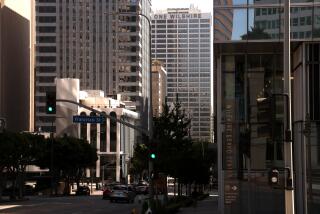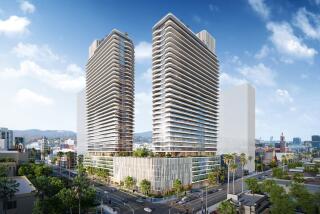Silicon Valley is having an architectural breakthrough
- Share via
For all the technological breakthroughs it has produced, Silicon Valley is an architectural wasteland.
Rather than complementing the lush rolling hills to the west and the expansive San Francisco Bay to the east, this high-tech hub has produced an unending line of dreary office parks full of two-story, cubicle-lined buildings whose main visual goal is to escape notice.
Yet amid this backdrop of bland, Silicon Valley is suddenly showing signs of architectural life. The latest evidence came last month when Nvidia Corp. of Santa Clara and then Google Inc. of Mountain View unveiled plans for elaborate new campuses.
Google’s new complex, dubbed Bay View, would be a series of bent, rectangular buildings connected by bridges arranged around courtyards and topped with green roofs. Nvidia’s campus would sport a space-age look with a pair of triangle-shaped buildings with geodesic roofs that mimic the miniature triangles used in computer graphic chips.
“The new Nvidia building will capture the ambition and imagination of our people,” said Jen-Hsun Huang, co-founder and chief executive of the computer chip maker. “It will stand at the intersection of science and art, just as our work in visual computing does. It will be the symbol, the physical manifestation, of our vision for the company.... You’ll see how it fuses together smart design, craftsmanship, and soul.”
Art? Soul? In Silicon Valley?
Believe it. Google and Nvidia are just the latest distinctive office designs that have been announced for the region. The most buzzed-about has been Apple Inc.’s spaceship-like campus in Cupertino. In Menlo Park, Facebook Inc. hired architect Frank Gehry to design its expansion.
And Samsung Electronics Co., the South Korean giant, has unveiled plans for a new facility in San Jose that includes office floors alternating with open-air parks and smaller buildings draped in greenery.
“It would definitely be a signature building for San Jose,” said Joseph Horwedel, the city’s director of planning.
Throw in the new San Francisco 49ers football stadium under construction in Santa Clara and the valley’s lone architectural wonder, the Stanford University campus in Palo Alto, and suddenly you have enough edificial eye candy to warrant a tour.
This game of one-upmanship is a long way from the stripped-down garages where tech companies such as Hewlett-Packard Co. and Apple got their start. That simple, no-frills aesthetic has guided Silicon Valley’s approach to work spaces, fashion sense and other matters ever since.
The prevailing view has long been to let the East Coasters worry about power business suits and architectural monuments to their egos. Things around here move too fast and change too rapidly to worry about looks. Better to keep it simple and disposable so as not to get attached, whether it’s hoodies worn by CEOs or generic office parks. And keeping things Spartan makes it easier to recycle a building, so when a Silicon Graphics or a Sun Microsystems dies, a Google or a Facebook can move in.
But of course, nothing is sacred here. And now that Silicon Valley is all grown up and its pockets are stuffed with cash, it’s ready to disrupt its own design sensibilities, or lack of them.
John Barton, director of the architectural design program at Stanford, said that building a campus from scratch has been rare in a region where companies usually let developers build offices and then rent them. The time, expense and energy that goes into building a campus lets companies make a bold statement: Our technologies will endure, and we intend to be in Silicon Valley for generations to come.
In addition, the emphasis on external designs seems to be a sign of the lingering influence of the late Steve Jobs and Apple’s success.
“These guys have discovered in the follow-up to all that Apple has done with product development that design matters,” Barton said. “They realize they have to compete on the look and feel of their products. And that goes for their buildings as well.”
Indeed, there seems to be a growing desire to stand out from the crowd of tech competitors for practical and strategic reasons. Free food, laundry and massages, and bring your dog to work: Anyone can offer those perks. Coming to work every day in a building that makes your jaw hit the floor? Well, only the truly elite employers can boast of that.
“Absolutely, that’s one of the cornerstones of competing in Silicon Valley,” said John Hankey, Nvidia’s vice president of real estate. “We think this building is going to be a reflection of the amazing things we do.”
Hankey said Nvidia began planning the new campus five years ago with conversations about how to create a different type of work space that would create an atmosphere that fosters new ideas.
The company wanted a building that put as many people as close together as possible, in ways they would constantly be circulating and having random interactions. Too many floors tend to kill that kind of vibe. So the building will have only two floors, each about 250,000 square feet and basically wide open allowing sweeping views across.
That motivation to create a unique work space also drove Samsung’s design.
Jonathan Ward, a design partner at the Los Angeles office of NBBJ, which designed the building for Samsung, said the company didn’t start with a request for a signature building. Instead, what it wanted was an interior work space that would inspire employees and promote collaboration, serendipity and innovation.
“The companies we’re working for are demanding something that’s different. More community, more connectivity, more synergy,” Ward said. “I think if you start with that approach it will lead to some really powerful expressions on the outside.”
To that end, Ward described see-through walkways that would connect the main buildings as “activated” because they would contain features such as a gym and meeting and social spaces — areas designed to draw people out of their cubicles to interact with people from other parts of the company.
This design thinking about the inside then led back to creating something more dramatic and effective on the outside, Ward said.
“Conceptually, Silicon Valley is a very fertile valley,” Ward said. “Steve Jobs talked about his connection to the outdoors. So we said, ‘Let’s take that approach. Let’s make sure every employee has access to the outdoors within one floor.’”
Google appears to have taken a similar approach, starting with what happens on the inside and then working out. Last week the company announced plans for a new complex of nine buildings totaling 1.1 million square feet. Writing in Vanity Fair magazine, architectural critic Paul Goldberger said Google had crunched data on workers’ behavior to optimize “casual collisions of the work force,” ensuring that all employees are within a 2.5-minute walking distance.
How far this new trend goes remains to be seen. But Ward said it’s a welcome departure, and a long-overdue indication that something perhaps much more fundamental has shifted in the way Silicon Valley relates to its work space.
“Maybe people have had enough of plain-vanilla buildings,” he said.
More to Read
Inside the business of entertainment
The Wide Shot brings you news, analysis and insights on everything from streaming wars to production — and what it all means for the future.
You may occasionally receive promotional content from the Los Angeles Times.











